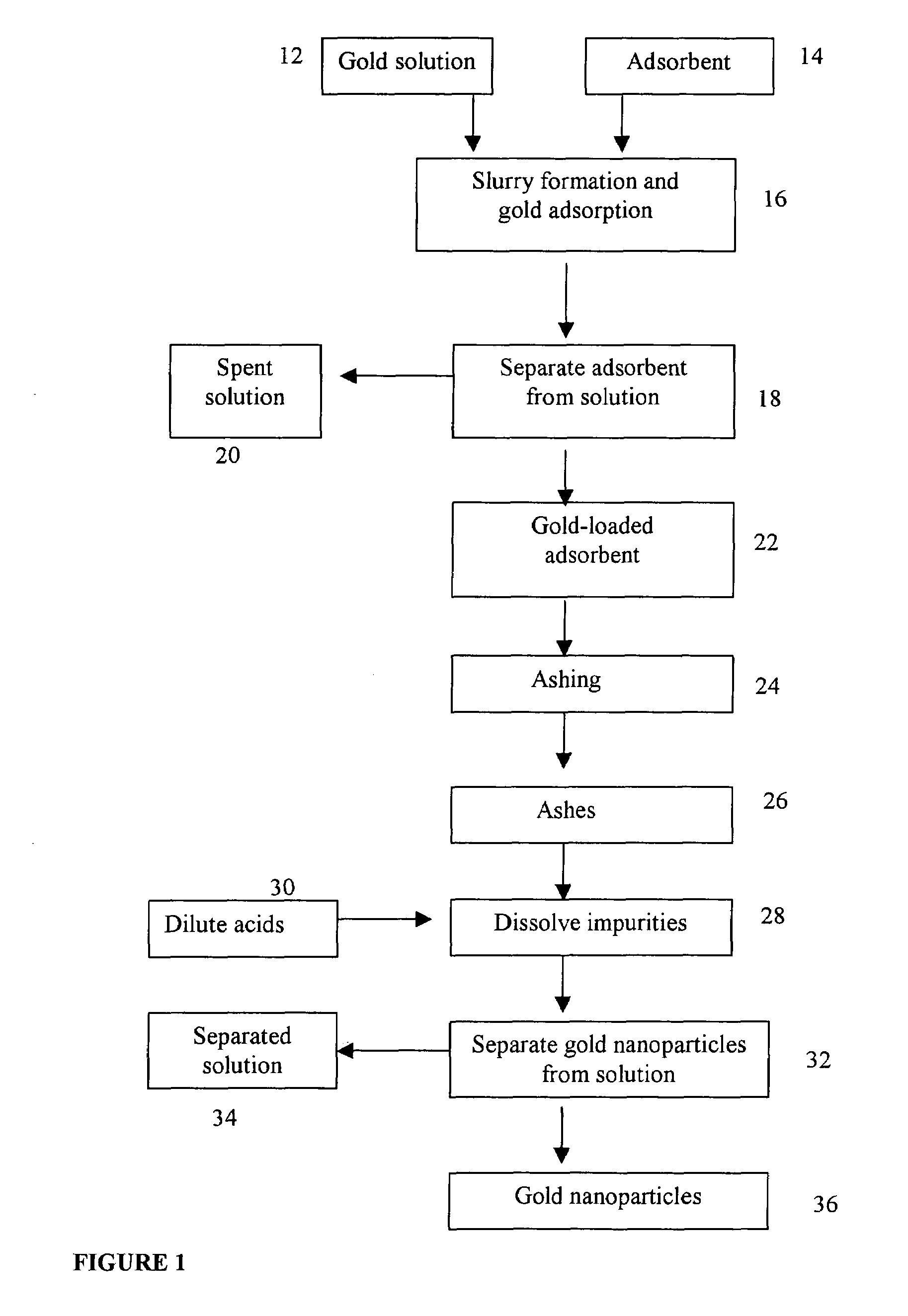Method of producing gold nanoparticle
a nanoparticle and gold technology, applied in the field of gold nanoparticle production, can solve the problems of high cost of approaches and often involve pollution-generating processes
- Summary
- Abstract
- Description
- Claims
- Application Information
AI Technical Summary
Benefits of technology
Problems solved by technology
Method used
Image
Examples
example 1
[0012]Activated carbon was used as the adsorbent to adsorb gold from gold cyanide complex solution. At the completion of the adsorption, the loaded carbon contains 2.4 grams of gold per kilogram of carbon. The loaded carbon was ashed in a muffle furnace at 750 degrees Centigrade (° C.) for 4 hours. The resulting ashes were mixed with dilute acids to dissolve the impurities and gold nanoparticles were obtained as the centrifuge product. The gold nanoparticles were examined using a scanning electron microscope with energy-dispersed x-ray. The energy-dispersed x-ray is used to confirm the gold nanoparticles and the scanning electron microscope is used to examine the particle size and shape. It is clearly shown, from scanning electronic microscope images, that gold particles sinter together in this sample. The sintered gold particles range from 0.5 to 2 microns in size.
example 2
[0013]Activated carbon was used as the adsorbent to adsorb gold from gold cyanide complex solution. At the completion of the adsorption, the loaded carbon contains 2.4 grams of gold per kilogram of carbon. The loaded carbon was ashed in a muffle furnace at 650° C. for 5 hours. The resulting ashes were mixed with dilute acids to dissolve the impurities and gold nanoparticles were obtained as the centrifuge product. The gold nanoparticles were examined using a scanning electron microscope with energy-dispersed x-ray. The sintering effect is much less severe in this sample (Sample 2) than in the Sample 1. The gold particle size ranges from 0.1 to 0.5 micron or 100 to 500 nanometers. The smaller gold particle size, compared to Sample 1, is expected, as the loaded carbon was ashed at a lower temperature, thus causing a less severe sintering effect.
example 3
[0014]Activated carbon was used as the adsorbent to adsorb gold from gold cyanide complex solution. At the completion of the adsorption, the loaded carbon contains 0.18 grams of gold per kilogram of carbon. The loaded carbon was ashed in a muffle furnace at 650° C. for 5 hours. The resulting ashes were mixed with dilute acids to dissolve the impurities and gold nanoparticles were obtained as the centrifuge product. The sintering effect is less severe in this sample (Sample 3) than in the Sample 2. The test produced gold nanoparticles of about 50 nanometers. With a lower gold content in the loaded carbon, compared to Sample 2, the gold particles become smaller when gold cyanide complex is reduced and gold particles crystallize in the ashing step.
PUM
| Property | Measurement | Unit |
|---|---|---|
| size | aaaaa | aaaaa |
| particle size | aaaaa | aaaaa |
| particle size | aaaaa | aaaaa |
Abstract
Description
Claims
Application Information
 Login to View More
Login to View More - R&D
- Intellectual Property
- Life Sciences
- Materials
- Tech Scout
- Unparalleled Data Quality
- Higher Quality Content
- 60% Fewer Hallucinations
Browse by: Latest US Patents, China's latest patents, Technical Efficacy Thesaurus, Application Domain, Technology Topic, Popular Technical Reports.
© 2025 PatSnap. All rights reserved.Legal|Privacy policy|Modern Slavery Act Transparency Statement|Sitemap|About US| Contact US: help@patsnap.com


